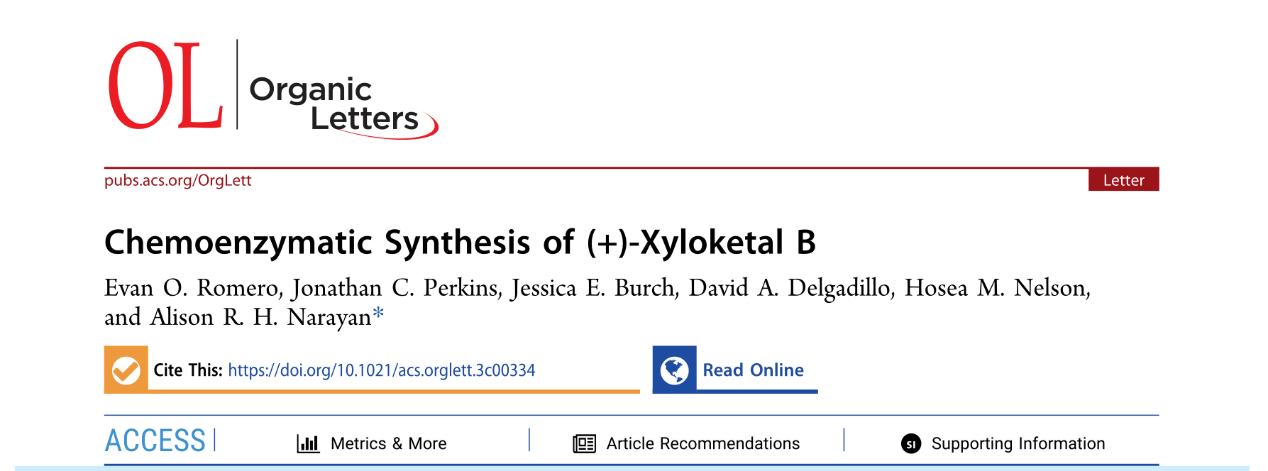-
+86 18962587269
-
contact@readcrystal.com
-
Changshu High-tech Industrial Development Zone, Suzhou, Jiangsu Province

On February 24th and February 13th, the University of Michigan and Kitasato University in Japan each released groundbreaking articles in the field of natural products. Both natural products mentioned in the articles involve the identification of absolute configuration. Interestingly, both authors have abandoned traditional identification methods and embraced the cutting-edge MicroED technology.

Abstract: Xyloketal B is a pentacyclic fungal marine natural product that has shown potential in treating diseases such as Alzheimer's and atherosclerosis. Here, we report the first asymmetric synthesis of this natural product, relying on a chemoenzymatic strategy. The method utilizes biocatalytic benzyl hydroxylation to obtain a quinone methide intermediate, which is captured in a [4 + 2] cycloaddition to stereoselectively generate a key cyclic ketone intermediate, leading to (+)-xyloketal B. The relative configuration of this intermediate was rapidly confirmed to be the desired stereoisomer using MicroED. To complete the synthesis, a second quinone methide intermediate was obtained through a reduction method, ultimately leading to the stereoselective synthesis of (+)-dihydrotoluquinone B.

The stereochemistry of the key ring-contracted ketone intermediate in the synthesis of (+)-p-menthane-2,8-dione B was confirmed by MicroED.

Abstract: In our antifungal screening program, a new polyketide compound named hakuhybotrol (1), along with six known analogs, cladobotric acids F (2), E (5), H (6), and A (7), pyrenulic acid A (3), and F2928-1 (4), were isolated from the culture broth of the parasitic fungus Hypomyces pseudocorticiicola FKA-73.
The structure of compound 1 was determined by comprehensive analysis of high-resolution mass spectrometry and 1D and 2D NMR, and its absolute configuration was determined by chemical derivatization, single-crystal X-ray diffraction (SCXRD), and three-dimensional electron diffraction/microscopy (3D ED/MicroED). The relative configuration of compound 4 was revised, and its absolute configuration was determined by conversion to compound 1. Compounds 3-7 showed antifungal activity against azole-sensitive and azole-resistant Aspergillus spp. and exhibited the same resistance against the fungal pathogen Candida auris. Among them, the most effective antifungal analogs 4 and 5 were detected in the MeOH extract of the mushroom parasitized by Hypomyces sp. strains collected from natural environments showed antifungal activity against mushrooms. Our results suggest that parasitic fungi are a useful source of lead antifungal compounds and 3D ED/MicroED is highly effective for structural analysis of natural products."

The absolute configuration of Hakuhybotrol was determined by MicroED and later confirmed by SCXRD data comparison. The comparison results proved that the results obtained by MicroED were consistent and reliable.
This is the first time that the absolute configuration of a natural compound has been directly elucidated using 3D ED/MicroED and confirmed through derivatization and SCXRD.
Why is MicroED technology favored in the field of natural products? This depends on the unique advantages of this technique. As a crystallographic structure analysis method, MicroED only requires small nanoscale crystals to collect diffraction data, and it is particularly effective for needle-shaped crystals and powder crystals. This eliminates the time-consuming single-crystal cultivation process. Additionally, due to the small sample requirement and the ability to independently analyze the structure of components in mixtures, this technique perfectly addresses the pain points of low natural product yield and impure phases. Finally, MicroED can also determine the chirality of compounds, similar to X-ray diffraction.
This emerging structure analysis technique not only rapidly impacts the field of natural products but also plays an important role in structural biology and organic materials. In February 2023, six articles from different disciplines used MicroED technology to confirm the spatial three-dimensional structures of crystals. This dense number of publications is evidence that MicroED has become an efficient and practical tool in the field of scientific research.
What is MicroED?
MicroED technology, or Microcrystal Electron Diffraction/Three-dimensional Electron Diffraction, represents an innovative approach to analyzing crystal structures based on electron microscopy. Its principle is similar to X-ray diffraction, but the incident beam is high-energy electrons, which have a shorter wavelength and stronger interaction with the crystal. Therefore, only a small amount of micro- or nano-sized crystals are needed to quickly obtain electron diffraction data.
How does MicroED achieve absolute configuration analysis?
Chiral compounds exhibit distinct dynamic effects depending on their chirality. When determining the relative configuration of chiral compounds, the differences in dynamic effects can be used in a reverse manner to validate the absolute configuration through dynamic refinement.
What are the advantages of MicroED?
● Micro- and nano-sized crystals
● Compared to traditional X-ray diffraction, MicroED requires very small crystal sizes. With MicroED, diffraction data can be obtained from crystals larger than 100 nanometers under the electron microscope.
● Timesaving
● Particularly advantageous when dealing with powder-like samples. Even if such samples contain minuscule crystals, MicroED can reveal crystals of the required size, negating the need for the laborious process of cultivating single crystals.
● Independent structure analysis of mixed samples
● Direct identification of distinct phases within mixed component samples and facilitates the analysis of the structures of pure phases under the electron microscope.
Scope of application of MicroED
● Small molecule drugs, natural products, co-crystals, PROTAC, peptide drugs
● Proteins, protein-ligand complexes
● Organic materials.
Next page
+86 18962587269
contact@readcrystal.com
Changshu High-tech Industrial Development Zone, Suzhou, Jiangsu Province